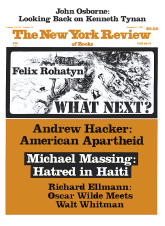In response to:
Mad About the Guy from the July 16, 1987 issue
To the Editors:
…I disagree with Professor Shattuck’s claim [in his review of Mario Vargas Llosa’s The Perpetual Orgy, NYR, July 16] that “In his [Vargas Llosa’s] own novels of high adventure and political acuteness he doesn’t write like Flaubert. His powerful and flexible narrative style has absorbed many influences.” Although other writers influenced him (especially Sartre and Dos Passos), none of them rivals Flaubert in importance. All of Vargas Llosa’s books contain echoes, reinscriptions, and reinterpretations of Flaubert. Not only The Perpetual Orgy but his entire oeuvre may be seen as one long meditation on Flaubert.
His first novel La Ciudad y los perros (Time of the Heroes) takes place in a military school in Lima. In setting and in technique, the book seems to grow out of the first chapter of Madame Bovary, when “Charbovary,” wearing a ridiculous hat, arrives at school for the first time and an unidentified narrator describes the impression that this new pupil makes upon “us.” In The Perpetual Orgy Vargas Llosa reflects at some length on the presence of this anonymous narrator. “…the vagueness of the narrator—who is there but doesn’t show himself…provokes a curiosity…the initial narrator of Madame Bovary infects the narrative material with some mystery, envelops it in a disconcerting aura.” Vargas Llosa might as well be speaking of his own novel, where the mystery is compounded as the story unfolds through the testimony of different eyewitnesses—narrators who are not identified until the end of the book.
Vargas Llosa’s next novel, La Casa verde (1965) (The Green House), is set in different regions of Peru, in the jungle and on the high plains, in a monastery and a brothel. As he acknowledged in Historia secreta de una novela, the book’s title and its central image of the brothel were based upon his (somewhat mistaken) remembrance of the Turk’s house in L’education sentimentale.
One of the narrative techniques used extensively in this work and in subsequent novels by Vargas Llosa is that of intertwining dialogues, developed by Flaubert in the Comices Agricoles scene in Madame Bovary. While in Flaubert the two dialogues took place simultaneously, Vargas Llosa expands this technique to encompass two different places and two different moments in time, one in the here and now, the other evoked and made present by the first.
The same principle of contrapuntal voices forms the basis for one of Vargas Llosa’s most ambitious works, Conversación en la Catedral, published in 1971. The four-hour conversation in the bar called the Cathedral is recounted in non-linear fashion. Like Flaubert, Vargas Llosa narrates by omission, using silences, blanks in the text, and ironic understatement to show the corruption that characterized the Ondría regime in Peru in the 1950s. The novel expresses the historical reality of that period, much as L’education sentimentale expressed the truth of 1848, separating rhetoric from reality and showing how speech was bound up with social position, geographical location, and political power.
Both Conversación en la Catedral and Vargas Llosa’s next novel, Pantaleón y las Visitadoras (Captain Pantoja and the Special Service) (1973) (completed immediately before he undertook The Perpetual Orgy), exhibit the author’s growing interest in different kinds of discourse, an interest that he shares with Flaubert, who made it the subject not only of his Dictionnaire des idées reçues but also of his last unfinished novel, Bouvard et Pécuchet.
The epigram for Pantaleón comes from Flaubert’s Education sentimentale—“There are some men whose only mission among others is to act as intermediaries; one crosses them like bridges and keeps going.” Both Flaubert and Vargas Llosa deploy parodic discourses, satiric techniques, and deadpan humor to criticize bureaucrats and to underscore the irrationality of rational procedures. In both works the protagonists repeat clichés and received ideas. The humor comes from the juxtaposition of official discourses and jargons of different fields of specialization with an intractable reality that always defies efforts to be controlled and managed.*
Even Vargas Llosa’s recently translated epic novel, La Guerra del fin del mundo (War of the End of the World), set in Brazil at the turn of the century, shares epic qualities with Flaubert’s Salammbô. As he notes in The Perpetual Orgy, what Vargas Llosa appreciates in Salammbô, is the “alternation between the collectivity and the individual. The banquets, the celebrations, the ceremonies…and above all, the battles in Salammbô still retain a dynamism, a plasticity and an elegance that have not since been seen in literature.”…
Katherine S. Kovacs
Roger Shattuck replies:
I thank Professor Kovacs for pointing out in Vargas Llosa’s fiction epigraphs, themes, and details that echo Flaubert. She has in my judgment oversimplified the matter of Flaubert’s influence on his narrative style, particularly in The War of the End of the World.
This Issue
December 3, 1987
-
*
On this point see my article, “The Bureaucratization of Knowledge and Sex in Flaubert and Vargas Llosa,” Comparative Literature Studies, Vol. 21, No. 1 (Spring, 1984).
↩



